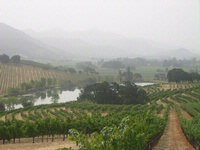RUTHERFORD, Ca. — Down through the years I’ve enjoyed many vintages of Quintessa, one of the Napa Valley’s ultra-premium Cabernet Sauvignons, but never fully understood the unusual characteristics of the estate, which are ultimately as important to the final product as the care and skill of the winemaking team.
 Quintessa lies between the Silverado Trail and Highway 29, the two main north-south arteries that run parallel through the Valley near the village of Rutherford. The Napa River slides through this district on its way to the San Pablo Bay, and the famed Rutherford Bench is the terroir that anyone with an understanding of the geography of the region would associate with the Quintessa wines.
Quintessa lies between the Silverado Trail and Highway 29, the two main north-south arteries that run parallel through the Valley near the village of Rutherford. The Napa River slides through this district on its way to the San Pablo Bay, and the famed Rutherford Bench is the terroir that anyone with an understanding of the geography of the region would associate with the Quintessa wines.
I’ve driven past the gates of Quintessa a thousand times, but never stopped for a visit until Friday, when I had scheduled a tasting appointment and tour with winemaker Charles Thomas, a legendary figure in the Valley who’s made the wines for Robert Mondavi, Rudd and Cardinale over a storied career.
We hopped into a Range Rover and headed off into the vineyards, and to my surprise we started to climb a steep hill. When we reached the top we were high on a ridge line that looked down on the Silverado Trail on one side, down on the Rutherford Bench on the other.
Silly me, I had long assumed the vineyard land between the two highways was flat — or nearly flat — in this part of the valley. What’s worse, I typically lodge at the Rancho Caymus Inn in Rutherford and even after all these years I had no idea there was a huge hill behind me, between the Inn and the Silverado Trail.
“It’s deceptive,” said Thomas. “From Highway 29 it just looks like the start of the hills on the eastern edge of the valley. From the Silverado Trail, you don’t get the perception of elevation.”
Why is this important? Well, there are three distinct exposures to the sun in the Napa Valley.
 One is the eastern range of mountains, including Howell Mountain and the Pritchard Hill area. Vineyards there catch the late afternoon sun, are generally above the fog line and the result is typically more darkly fruited, jammier wines with sweet tannins.
One is the eastern range of mountains, including Howell Mountain and the Pritchard Hill area. Vineyards there catch the late afternoon sun, are generally above the fog line and the result is typically more darkly fruited, jammier wines with sweet tannins.
The second is the valley floor, with more fertile soils and more even sun exposure. The wines tend to have bright fruit and a fleshy, supple, juicy character.
The third is the western range of mountains (Mount Veeder, Spring Mountain and Diamond Mountain) and the vineyards there catch the morning sun. While generally above the fog line, vineyards there produce grapes that typically express more cool-climate character (red fruits, harder tannins) due to their closer proximity to the Pacific and the fact they are shaded by the western peaks late in the day.
Because of the ridge line that rises 500 to 600 feet through the middle of its estate, Quintessa has the benefit of all three exposures, making it unique among wineries located between the mountains on the valley floor.
This is one reason — and there are others, such as the three distinct mother soils, but that’s another story for another day — for the remarkable complexity, texture and personality of the Quintessa wines.
8
